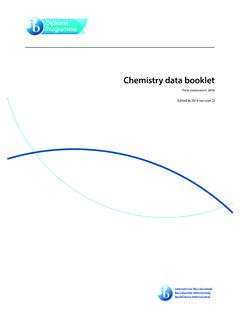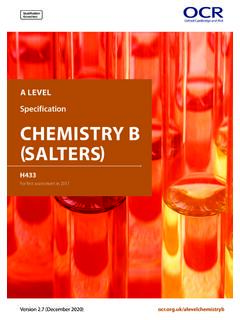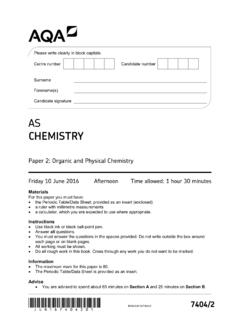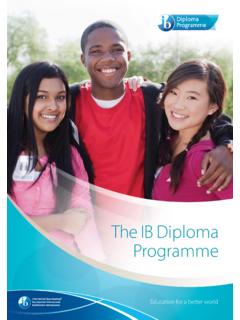Transcription of Chemistry guide
1 Chemistry guideFirst assessment 2016 Chemistry guideFirst assessment 20164070 international baccalaureate , Baccalaur at international and Bachillerato Internacional are registered trademarks of the international baccalaureate ProgrammeChemistry guidePublished February 2014 Published on behalf of the international baccalaureate Organization, a not-for-profit educational foundation of 15 Route des Morillons, 1218 Le Grand-Saconnex, Geneva, Switzerland by theInternational baccalaureate Organization (UK) LtdPeterson House, Malthouse Avenue, Cardiff GateCardiff, Wales CF23 8 GLUnited KingdomWebsite: international baccalaureate Organization 2014 The international baccalaureate Organization (known as the IB) offers four high-quality and challenging educational programmes for a worldwide community of schools, aiming to create a better, more peaceful world.
2 This publication is one of a range of materials produced to support these IB may use a variety of sources in its work and checks information to verify accuracy and authenticity, particularly when using community-based knowledge sources such as Wikipedia. The IB respects the principles of intellectual property and makes strenuous efforts to identify and obtain permission before publication from rights holders of all copyright material used. The IB is grateful for permissions received for material used in this publication and will be pleased to correct any errors or omissions at the earliest rights reserved. No part of this publication may be reproduced, stored in a retrieval system, or transmitted, in any form or by any means, without the prior written permission of the IB, or as expressly permitted by law or by the IB s own rules and policy.
3 See merchandise and publications can be purchased through the IB store at General ordering queries should be directed to the Sales and Marketing Department in : mission statementThe international baccalaureate aims to develop inquiring, knowledgeable and caring young people who help to create a better and more peaceful world through intercultural understanding and this end the organization works with schools, governments and international organizations to develop challenging programmes of international education and rigorous programmes encourage students across the world to become active, compassionate and lifelong learners who understand that other people, with their differences, can also be right. international baccalaureate Organization 2014 Chemistry guideviiiviiiContentsIntroduction 1 Purpose of this document 1 The Diploma Programme 2 Nature of science 6 Nature of Chemistry 13 Aims 18 Assessment objectives 19 Syllabus 20 Syllabus outline 20 Approaches to the teaching of Chemistry 22 Syllabus content 27 Assessment 167 Assessment in the Diploma Programme 167 Assessment outline SL 169 Assessment outline HL 170 External assessment 171 Internal assessment 173 The group 4 project 185 Appendices 190 Glossary of command terms 190 Bibliography 193 Chemistry guide11 IntroductionPurpose of this documentThis publication is intended to guide the planning.
4 Teaching and assessment of the subject in schools. Subject teachers are the primary audience, although it is expected that teachers will use the guide to inform students and parents about the guide can be found on the subject page of the online curriculum centre (OCC) at , a password-protected IB website designed to support IB teachers. It can also be purchased from the IB store at resourcesAdditional publications such as teacher support materials, subject reports, internal assessment guidance and grade descriptors can also be found on the OCC. Past examination papers as well as markschemes can be purchased from the IB are encouraged to check the OCC for additional resources created or used by other teachers. Teachers can provide details of useful resources, for example: websites, books, videos, journals or teaching IB wishes to thank the educators and associated schools for generously contributing time and resources to the production of this assessment 2016 Chemistry guide22 IntroductionThe Diploma ProgrammeThe Diploma Programme is a rigorous pre-university course of study designed for students in the 16 to 19 age range.
5 It is a broad-based two-year course that aims to encourage students to be knowledgeable and inquiring, but also caring and compassionate. There is a strong emphasis on encouraging students to develop intercultural understanding, open-mindedness, and the attitudes necessary for them to respect and evaluate a range of points of Diploma Programme modelThe course is presented as six academic areas enclosing a central core (see figure 1). It encourages the concurrent study of a broad range of academic areas. Students study two modern languages (or a modern language and a classical language), a humanities or social science subject, a science, mathematics and one of the creative arts. It is this comprehensive range of subjects that makes the Diploma Programme a demanding course of study designed to prepare students effectively for university entrance.
6 In each of the academic areas students have flexibility in making their choices, which means they can choose subjects that particularly interest them and that they may wish to study further at 1 Diploma Programme modelThe Diploma Programme Chemistry guide3 Choosing the right combinationStudents are required to choose one subject from each of the six academic areas, although they can, instead of an arts subject, choose two subjects from another area. Normally, three subjects (and not more than four) are taken at higher level (HL), and the others are taken at standard level (SL). The IB recommends 240 teaching hours for HL subjects and 150 hours for SL. Subjects at HL are studied in greater depth and breadth than at both levels, many skills are developed, especially those of critical thinking and analysis. At the end of the course, students abilities are measured by means of external assessment.
7 Many subjects contain some element of coursework assessed by teachers. The core of the Diploma Programme modelAll Diploma Programme students participate in the three course elements that make up the core of the model. Theory of knowledge (TOK) is a course that is fundamentally about critical thinking and inquiry into the process of knowing rather than about learning a specific body of knowledge. The TOK course examines the nature of knowledge and how we know what we claim to know. It does this by encouraging students to analyse knowledge claims and explore questions about the construction of knowledge. The task of TOK is to emphasize connections between areas of shared knowledge and link them to personal knowledge in such a way that an individual becomes more aware of his or her own perspectives and how they might differ from , action, service (CAS) is at the heart of the Diploma Programme.
8 The emphasis in CAS is on helping students to develop their own identities, in accordance with the ethical principles embodied in the IB mission statement and the IB learner profile. It involves students in a range of activities alongside their academic studies throughout the Diploma Programme. The three strands of CAS are Creativity (arts and other experiences that involve creative thinking), Action (physical exertion contributing to a healthy lifestyle) and Service (an unpaid and voluntary exchange that has a learning benefit for the student). Possibly, more than any other component in the Diploma Programme, CAS contributes to the IB s mission to create a better and more peaceful world through intercultural understanding and extended essay, including the world studies extended essay, offers the opportunity for IB students to investigate a topic of special interest, in the form of a 4,000-word piece of independent research.
9 The area of research undertaken is chosen from one of the students Diploma Programme subjects, or in the case of the interdisciplinary world studies essay, two subjects, and acquaints them with the independent research and writing skills expected at university. This leads to a major piece of formally presented, structured writing, in which ideas and findings are communicated in a reasoned and coherent manner, appropriate to the subject or subjects chosen. It is intended to promote high-level research and writing skills, intellectual discovery and creativity. As an authentic learning experience it provides students with an opportunity to engage in personal research on a topic of choice, under the guidance of a Diploma Programme Chemistry guide4 Approaches to teaching and approaches to learningApproaches to teaching and learning across the Diploma Programme refer to deliberate strategies, skills and attitudes which permeate the teaching and learning environment.
10 These approaches and tools, intrinsically linked with the learner profile attributes, enhance student learning and assist student preparation for the Diploma Programme assessment and beyond. The aims of approaches to teaching and learning in the Diploma Programme are to: empower teachers as teachers of learners as well as teachers of content empower teachers to create clearer strategies for facilitating learning experiences in which students are more meaningfully engaged in structured inquiry and greater critical and creative thinking promote both the aims of individual subjects (making them more than course aspirations) and linking previously isolated knowledge (concurrency of learning) encourage students to develop an explicit variety of skills that will equip them to continue to be actively engaged in learning after they leave school, and to help them not only obtain university admission through better grades but also prepare for success during tertiary education and beyond enhance further the coherence and relevance of the students Diploma Programme experience allow schools to identify the distinctive nature of an IB Diploma Programme education, with its blend of idealism and five approaches to learning (developing thinking skills, social skills, communication skills, self-management skills and research skills) along with the six approaches to teaching (teaching that is inquiry-based, conceptually focused, contextualized, collaborative, differentiated and informed by assessment)







